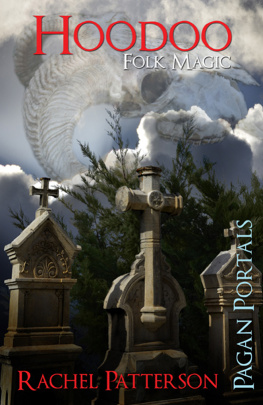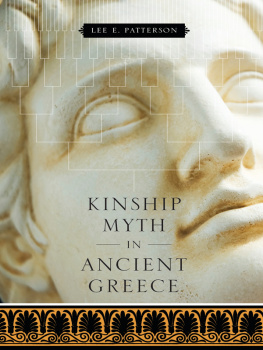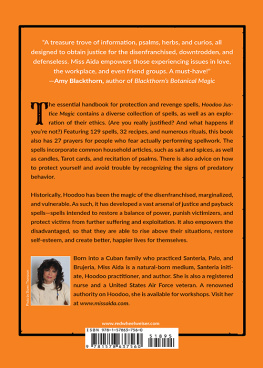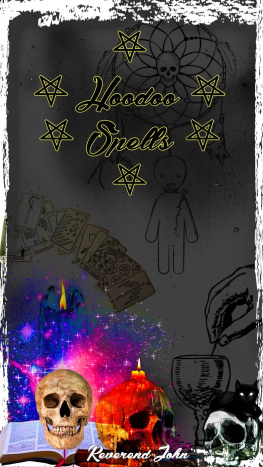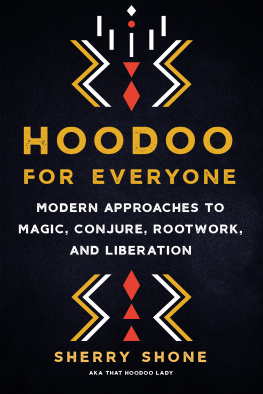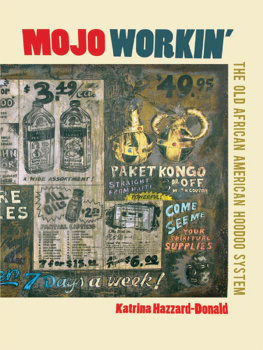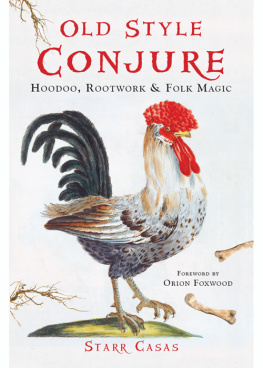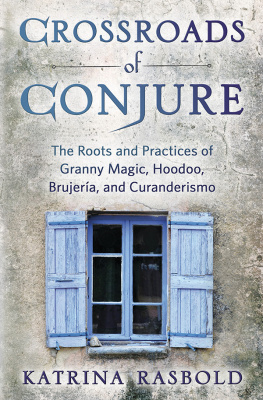Patterson - Hoodoo: Folk Magic (Pagan Portals)
Here you can read online Patterson - Hoodoo: Folk Magic (Pagan Portals) full text of the book (entire story) in english for free. Download pdf and epub, get meaning, cover and reviews about this ebook. City: Winchester;UK, year: 2013, publisher: Moon Books;John Hunt Publishing, genre: Home and family. Description of the work, (preface) as well as reviews are available. Best literature library LitArk.com created for fans of good reading and offers a wide selection of genres:
Romance novel
Science fiction
Adventure
Detective
Science
History
Home and family
Prose
Art
Politics
Computer
Non-fiction
Religion
Business
Children
Humor
Choose a favorite category and find really read worthwhile books. Enjoy immersion in the world of imagination, feel the emotions of the characters or learn something new for yourself, make an fascinating discovery.
- Book:Hoodoo: Folk Magic (Pagan Portals)
- Author:
- Publisher:Moon Books;John Hunt Publishing
- Genre:
- Year:2013
- City:Winchester;UK
- Rating:4 / 5
- Favourites:Add to favourites
- Your mark:
- 80
- 1
- 2
- 3
- 4
- 5
Hoodoo: Folk Magic (Pagan Portals): summary, description and annotation
We offer to read an annotation, description, summary or preface (depends on what the author of the book "Hoodoo: Folk Magic (Pagan Portals)" wrote himself). If you haven't found the necessary information about the book — write in the comments, we will try to find it.
Hoodoo: Folk Magic (Pagan Portals) — read online for free the complete book (whole text) full work
Below is the text of the book, divided by pages. System saving the place of the last page read, allows you to conveniently read the book "Hoodoo: Folk Magic (Pagan Portals)" online for free, without having to search again every time where you left off. Put a bookmark, and you can go to the page where you finished reading at any time.
Font size:
Interval:
Bookmark:


First published by Moon Books, 2013
Moon Books is an imprint of John Hunt Publishing Ltd., Laurel House, Station Approach,
Alresford, Hants, SO24 9JH, UK
www.johnhuntpublishing.com
www.moon-books.net
For distributor details and how to order please visit the Ordering section on our website.
Text copyright: Rachel Patterson 2012
ISBN: 978 1 78279 020 4
All rights reserved. Except for brief quotations in critical articles or reviews, no part of this book may be reproduced in any manner without prior written permission from the publishers.
The rights of Rachel Patterson as author have been asserted in accordance with the Copyright,
Designs and Patents Act 1988.
A CIP catalogue record for this book is available from the British Library.
Design: Stuart Davies
Printed and bound by CPI Group (UK) Ltd, Croydon, CR0 4YY
We operate a distinctive and ethical publishing philosophy in all areas of our business, from our global network of authors to production and worldwide distribution.
My craft name is Tansy Firedragon. I have been a witch for many years now and have studied many areas within the Craft.
I am High Priestess in my own coven co-run by my lovely sisters in the Craft, the Kitchen Witch Coven of Natural Witchery, as well as being a member of the Dorset Grove Druids, which allows me to attend lots of outside rituals in wonderful sacred places within the UK.
I am co-founder and a leadership team member of the online Kitchen Witch School of Natural Witchcraft.
My personal website: www.rachelpatterson.co.uk
My email:
My blog: www.tansyfiredragon.blogspot.co.uk
My facebook page: www.facebook.com/racheltansypatterson
My twitter page: www.twitter.com/tansyfiredragon
The Kitchen Witch School website:
www.kitchenwitchhearth.com
The Kitchen Witch School facebook page:
www.facebook.com/kitchenwitchuk
The Kitchen Witch blog: www.kitchenwitchuk.blogspot.co.uk
Now, I am not a born and bred hereditary Hoodoo root worker living in Georgia or New Orleans (I hope to come back in another lifetime as one though), but I have studied Hoodoo in great detail. I work with Hoodoo magic all the time and have incorporated it into my witchcraft. I have great respect for the practice of Hoodoo and all the practitioners who use it.
What I hope to do in this book is provide an introduction to this amazing and fascinating magical practice.
This is MY interpretation of Hoodoo and how I work with it within the Craft. I have tried to make it as accurate as possible and have drawn on many sources as well as my own experiences. I have included many original recipes for oils, powders, incenses etc and have tried to be as traditional as possible with the ingredients for the well known ones, but other recipes included here are my own blends and therefore may not be so traditional.
My intention is for this book to honour the art of Hoodoo and all those who practise it.
What is Hoodoo?
Hoodoo in the form that we know it can be traced back to the early 19th Century, and possibly earlier. Hoodoo is the American name for African American folk magic.
Many religions sprang from the African traditions, such as Yoruba, Santeria, Vodoun and Candombl. Hoodoo came out of those beliefs and is the magical practice, not an actual religion. It is definitely not Voodoo, as it is commonly called by mistake. Voodoo, or Vodou, is a Haitian African religion, while Vodoun is West African.
Hoodoo as we recognise it was established during the times of slavery in America using the native plants and items available to the people at the time and probably taking a little knowledge from the Native Americans too, with definitely some European folk magic thrown in to the mix as well. I do believe a good amount of the Hoodoo magical practices were brought by slaves; they didnt arrive as slaves with no beliefs or practices at all!
A lot of the slaves at the time were forced to follow the Catholic religion. What they did was to incorporate the saints, deities and rituals into their own religion. Santeria is a good example of this, although they also included the darker side of magic such as curses and hexes as well.
If you take a look into the blues music from the times of slavery you will find a huge amount of references to Hoodoo in the lyrics.
Hoodoo is a practice of magic which is based on surviving and the need for things such as healing using herbs, plants, roots, stones, minerals and the like, combined with chants, rituals and handmade items. It is based around a main framework of intents love, success, luck, happiness, health and wealth. It is also a form of magic that works with ones own personal power.
However, I suspect that those practitioners of Hoodoo in America rarely call it by a name, it is just what they do, what they grew up doing, what their mothers and grandmothers did. Hoodoo is often referred to by other names such as conjure or root work in fact a practitioner of this magical practice is often called a root worker or conjurer and sometimes referred to as a Hoodoo Doctor.
Like a lot of magical practices, Hoodoo uses the magical properties of natural items including traditional herbs, roots and minerals, but it also makes use of animal parts and bodily fluids. (No, dont worry you wont have to bash any wild animals, but you will be able to use bones from your Sunday lunch roast chicken or, if you arent too squeamish, road kill!)
The practice includes such things as jinxing, foot track magic, crossroads magic and laying tricks. Foot track magic works with the essence of the person by using their footprints. Crossroads magic works by leaving magical items at a crossroads (no surprise there!) or a place where two roads intersect. Crossroads are magical places and always have been. Probably the most well known item for a Hoodoo practitioner to use is a mojo bag, but in Hoodoo the use of candles, incense, oils, powders, talismans and spiritual washes is also common.
Originally those who worked with Hoodoo would probably have used whatever they could get their hands on, using lamps and plain white candles for spell work, dressing them only with blessed olive oil and using basic items and ingredients that they had to hand.
At some point in the history of Hoodoo, which my research seems to suggest having been about the time of the American Civil War, people started to market oils, coloured candles and vinegars; giving them the fantastic names that we now associate with Hoodoo products. But as with most magical practices my advice would be, use what seems right to you and use what you have to hand and what your intuition and instinct tell you is right. You dont need to splash out huge amounts of cash on branded products; you can make most things you need yourself. If you do purchase items from a shop or online I would just suggest you check out their credentials first and what ingredients they use; there are some wonderful retailers out there, but there are some bad ones too.
Come take a walk with me through the magical art of Hoodoo
Root Work
Root work is another name for Hoodoo; its practitioners are often referred to as root workers. It refers to the understanding of herbs and nature and, in particular, the belief that the root of a plant holds its power and spirit; plant roots being an important part of Hoodoo magical practice.
Font size:
Interval:
Bookmark:
Similar books «Hoodoo: Folk Magic (Pagan Portals)»
Look at similar books to Hoodoo: Folk Magic (Pagan Portals). We have selected literature similar in name and meaning in the hope of providing readers with more options to find new, interesting, not yet read works.
Discussion, reviews of the book Hoodoo: Folk Magic (Pagan Portals) and just readers' own opinions. Leave your comments, write what you think about the work, its meaning or the main characters. Specify what exactly you liked and what you didn't like, and why you think so.

